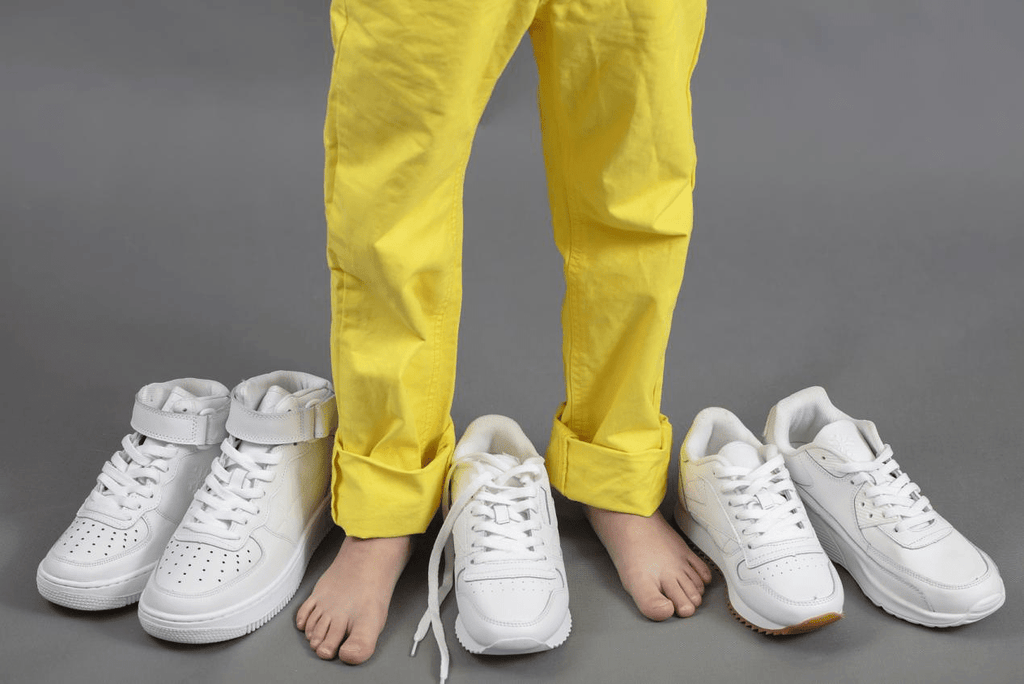How to Identify Genuine 4E Size Shoes?

Are your shoes feeling tight on the sides, even though they fit well in length? It could be a sign that you need a wide-width shoe. While you might consider buying a larger size for a broader fit, this can lead to extra space in the toe and heel, causing friction, blisters, changes in your gait, and even tripping hazards. When on the hunt for wide-fit shoes tailored to wider feet, it's vital to confirm if the shoe is truly wide as advertised. Let's debunk a common industry myth and reveal the reality behind genuine 2E and 4E shoe sizes.
Risk Alert: Wide Upper Meets Standard Sole
As someone with wide feet, it's essential for your weight to distribute evenly across the contact area of your feet to the floor. A regular sole doesn't achieve this because it doesn't match the width of your feet. It's common in the industry for some brands to use extra material on the upper to accommodate wide feet, but they don't always provide a wider sole for stable footing.
What Are the Risks of Wide-Fit Shoes with a Standard Sole?
When the shoe upper is wider than the sole, your foot may not be adequately supported, increasing the risk of tripping or falling. This imbalance can also cause your foot to roll inward or outward excessively, altering your natural walking pattern. Over time, this can lead to discomfort and potential injuries like overpronation or supination.
Embrace FitVille's Genuine 2E/4E/6E Shoes
FitVille has been specializing in crafting the most comfortable wide-fit shoes for individuals with foot conditions since 2018. Our shoes feature a wide platform that aligns perfectly with the shoe's width, whether you need 2E, 4E, or the maximum width of 6E. Whether you have edema, a severe toe condition, or simply need extra room, FitVille has you covered.

Here's a general guide to the width measurements for each size:
M (Medium): Standard width for most shoes.
2E (Wide): Approximately 1/4 inch wider than medium width.
4E (Extra Wide): Approximately 1/2 inch wider than medium width.
6E (Extra Extra Wide): Approximately 1 inch wider than medium width.
Explore our extra wide sizing with FitVille's size chart and learn how to measure your foot for wide-fit shoes here:
FitVille Women's Shoes Size Guide-M/2E/4E
FitVille Men's Shoes Size Guide-M/2E/4E/6E
FitVille's orthopedic shoes offer a wide platform that provides ample support and balance without appearing bulky or feeling heavy. The key lies in our ground-breaking PropelCore™ sole technology. Featuring dual-density midsoles, a shock-absorbing pad, heel ring, and a non-slip outsole, many of our customers have reported them to be the most comfortable shoes they've worn right out of the box.
Why Do a Wide Toe Box, Cushioning Sole, and Arch Support Matter?
It's more than just zero-break-in time. The orthopedic shoes focus on immediate pain relief, gait correction, and long-term healing for foot conditions. This is achieved through a combination of features such as a wide toe box, cushioning sole, and arch support, providing comfort, support, and stability without the need for an extended break-in period.

The Tremendous Impact of a Wide Toe Box
Narrow shoes that squeeze your feet can constrict blood flow, inhibiting the natural healing of tissues, interrupting natural bone and tendon alignment, and causing the body to respond to uneven landing pressure by adopting an unnatural gait. Bunions, hammertoes, Morton’s neuroma, metatarsalgia, plantar fasciitis, and Achilles tendon issues are common conditions contributed to and worsened by modern fashion shoes that prioritize a narrow forefoot and the appearance of smaller feet.
As one foot condition worsens without treatment, it often contributes to more related conditions, as our feet are a connected mechanism that is supposed to bear balanced pressure. The aggravated result usually begins with squeezing wide feet into narrow shoes and walking with an unnatural gait for years.
Thick Cushioning Soles vs. Barefoot Trend
A cushioned sole is ideal for elderly individuals with thinner foot tissue, offering comfort and relief from existing foot pain. Unlike many young people who prefer barefoot shoes, older and heavier individuals often shift to heel striking, necessitating better protection for the metatarsal and heel. We've taken a close look at how barefoot shoes can affect seniors and individuals carrying extra weight. Dive into our blog post, 'Are Barefoot Shoes Good for Flat Feet?' for more details!

Why Arch Support is Essential for Orthopedic Shoes?
Arch support can be beneficial for many foot conditions, including flat feet, high arches, plantar fasciitis, overpronation, toe conditions, and metatarsalgia.
Arch support helps by providing stability, redistributing pressure, and supporting the natural alignment of the foot. For example, in flat feet, arch support can help lift the arch to reduce strain on the plantar fascia. In high arches, it can help distribute weight more evenly and reduce pressure on the balls and heels of the feet. In plantar fasciitis, arch support can help reduce strain on the plantar fascia and alleviate pain. In toe and metatarsalgia conditions, arch support lifts the arch to distribute weight away from the painful forefoot, alleviating pressure and promoting natural healing with each step.
Having learned about the significance of arch support and the advantages of wide toe boxes and cushioned soles, you're now ready to find your perfect orthopedic shoes. Explore FitVille's wide range of sizes to discover the comfort and support you deserve. Bid farewell to discomfort and welcome relief. Your feet will thank you!
About FitVille Footwear
Just Follow us on LinkedIn, Facebook, YouTube, Instagram, RSS feed and Pinterest to catch our brand news.
What FitViller Prefers
Best Shoes to Buy

Popular Men's Shoes

Popular Women's Shoes


































